By Steven Tischler
Goldberger, Paul. Ballpark: Baseball in the American City. New York: Alfred A. Knopf, 2019.
Paul Goldberger deftly analyzes changing relationships between professional baseball and urban environments from the mid-19th century to the present day in Ballpark: Baseball in the American City. Goldberger uses ballparks as a lens through which to observe and understand urban history. In doing so, he can’t help but uncover more profound findings, such as the way commerce influenced the setting and style of recreation.
Where a ballpark is situated, Goldberger argues, inspires the design of the building and its prospects for success. Readers no doubt will appreciate Goldberger’s insights into why ballparks old (Fenway) and new (Camden Yards) stimulate adoration, and why many cheered when others (e.g., Candlestick Park and Shea Stadium) were decommissioned and replaced.
He begins his account with William Cammeyer’s efforts in 1862 to capitalize on widespread interest in baseball in Brooklyn. Prior to that point, baseball spectators watched games without having to pay any admission for contests on more-or-less flat land, where the occasional tree might be part of the field of play.
 Prior to creating what would be the nation’s first ballpark in the modern sense of the term, Cammeyer used his Union Grounds for horseback riding and ice-skating, but revenues derived from these recreations barely covered his expenses for the upkeep of the place. Cammeyer recognized that Brooklyn had so many baseball teams and players that, as a contemporary journalist declared, “every available plot of land within a ten-mile radius” was used for baseball play.
Prior to creating what would be the nation’s first ballpark in the modern sense of the term, Cammeyer used his Union Grounds for horseback riding and ice-skating, but revenues derived from these recreations barely covered his expenses for the upkeep of the place. Cammeyer recognized that Brooklyn had so many baseball teams and players that, as a contemporary journalist declared, “every available plot of land within a ten-mile radius” was used for baseball play.
As baseball became more popular, Cammeyer assayed his options. He could charge teams rent for the use of the finest baseball venue in town, now perfectly-flat and tree-less, or he could charge spectators an admission fee. He settled on the latter strategy, which became the business model that professional teams and leagues subsequently embraced. Goldberger reminds us that Cammeyer’s decision to exclude all who did not pay for a ticket was “a matter of capitalism, not ground rules.”
To enhance attendance at baseball games at his Union Grounds, Cammeyer segregated customers by class, building a roofed grandstand for gentlemen and their ladies and an uncovered area where gambling and drinking were tolerated (if not encouraged). Cammeyer provided the “equivalent of a saloon in the open air” to make a game even more enjoyable for many. Cammeyer wanted to get as many spectators into his baseball emporium as he could. The more people who watched a game and drank his beer from inside his building, the more profitable the outcome would be for him.

Goldberger rarely mentions Cammeyer’s enterprise after the early pages of this work, but the thinking behind the creation of the Union Grounds was instrumental in the larger formation and expansion of baseball and professional sports as a whole. In the future, the question of how to attract spectators to a professional game and how to get them to spend money there would be the primary questions that team owners, general managers, and league officials would address. Goldberger demonstrates Cammeyer’s pervasive influence on the business of baseball park construction through several stages: simply enclosing the grounds and charging admission; building brick, mortar, and steel edifices; creating cookie-cutter stadia that all look alike; evoking a nostalgic past through a post-modern aesthetic; and creating free-standing exurban “communities.” For more than a century and a half, the goal has been to monetize the fan experience in a way that transcends the game between the white lines.
Future team owners also took into account modes of transportation—streetcar, train, or automobile—that prospective customers used. Business connections between team owners, transportation moguls, and politicians generally determined whether a team would be located downtown, at the margins of a city, or outside the city altogether.
Demographic changes that were a function of broader economic factors, such as the Great Depression and the Post-War Boom, affected the growth of the baseball business. Where likely spectators lived influenced where teams located themselves—close to an urban transportation network, or, after World War II, near a freeway. The condition of residential neighborhoods affected a team’s decision to remain in an imperfect, sometimes crumbling part of town, or to move out of town entirely. Goldberg uses these criteria in his evaluation of the stadium model for each major league team.

As a writer whose focus is architecture, Goldberger offers vital insight into why ballpark design has changed along with urban and suburban landscapes. Perhaps the best part of this book is its insight into the deeper social framework that influenced the design of ballparks, just as they shaped Cammeyer’s sense of what was possible in the early 1860s.
Steven Tischler is a Professor of Historical Studies at SUNY Empire State College.
Featured image (at top): The Huntington Avenue Grounds, home to Boston baseball teams, during the 1903 World Series courtesy of wikimedia.
This post contains affiliate links. If you end up making a purchase, we may earn a commission on the sale. Thank you for supporting the hard work of writers and editors.


